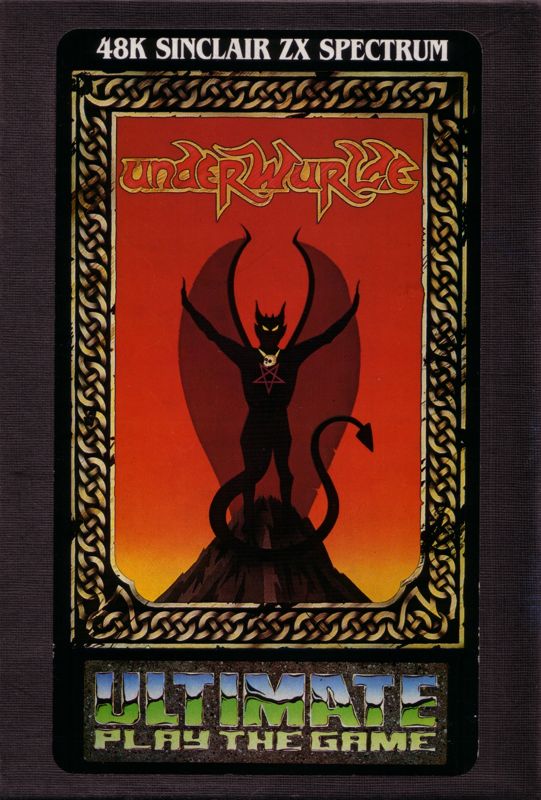Retro Replay Review
Gameplay
Underwurlde picks up where Sabre Wulf left off, trapping Sabreman deep in a sprawling underground cavern system. Players traverse nearly 600 interconnected side-view screens, each filled with platforms, ledges and hidden passageways. Progression hinges on exploring every nook and cranny in search of three key weapons—a dagger, a torch and a knife—which are required to defeat the guardians blocking the exits. This multi-branch escape mechanic encourages thorough exploration and replay, as each route offers a distinct challenge and layout.
(HEY YOU!! We hope you enjoy! We try not to run ads. So basically, this is a very expensive hobby running this site. Please consider joining us for updates, forums, and more. Network w/ us to make some cash or friends while retro gaming, and you can win some free retro games for posting. Okay, carry on 👍)
Encounters with nasties keep the tension high: bats and other creatures meander unpredictably, not able to kill Sabreman outright but certainly capable of knocking him into a deadly drop. The eagle foes introduce further peril by swooping in to grab the player mid-air, then releasing him over a chasm. A fall of more than one screen’s height costs you a life, making every leap a calculated risk. Fortunately, gems scattered throughout the map grant temporary invincibility, offering brief windows of safety as you navigate treacherous jumps.
The cavern network is split into two distinctive zones: the castle levels above and the cave tunnels below. In the castle, progression often relies on memorizing blind jumps and ricocheting off environmental objects like flower pots or breakable blocks. Down in the caverns, a rope—once found—allows you to hook onto the ceiling and traverse vertical shafts with precision. An on-screen depth indicator helps you track how far you’ve descended, adding context to your exploration and subtly encouraging deeper dives into the labyrinth.
Graphics
Underwurlde’s graphics are a showcase of early ’80s home-computer ingenuity. On platforms like the ZX Spectrum, the palette is limited but cleverly used: bright character sprites stand out against muted backgrounds, ensuring hazards and pickups remain clearly visible. Character designs are simple yet expressive—Sabreman’s jaunty top hat and coat remain recognizable as he scrambles across ledges and swings from ropes.
The game alternates between the sunlit castle chambers and the dimly lit caverns below, providing visual variety that keeps the exploration fresh. Castle rooms feature patterned brickwork, columns and decorative flower pots, whereas the caverns boast rugged stalactites, pools of water and vine-covered walls. Each screen feels carefully composed, with foreground objects serving both aesthetic and gameplay purposes—sometimes as launchpads for blind jumps, other times as obstacles to avoid.
While sprite flicker can occur when too many objects populate the screen, this is a common quirk of the era and rarely detracts from gameplay. In motion, Sabreman’s walk and jump animations are fluid enough to give players confidence in their timing. Overall, Underwurlde’s visuals strike a satisfying balance between functional clarity and atmospheric detail, making every new area worth a moment’s admiration.
Story
Story in Underwurlde is minimalistic but effective: following the events of Sabre Wulf, Sabreman finds himself tumbling into an underground maze with no clear way out. The narrative goal—escape—drives every action, and the game’s lore unfolds through item descriptions and the repeated confrontations with the three fearsome guardians. Each guardian hints at deeper mysteries of the underworld, lending weight to the challenge of defeating them.
There’s no text-heavy exposition here; instead, atmosphere builds through level design and the sense of vertical descent. The constant reminder of “how many screens deep” you are adds a subtle narrative hook: the deeper you go, the more remote and perilous your surroundings feel. Occasional touches—such as scattered bones, dripping water graphics and echoing footsteps (in compatible audio versions)—suggest a subterranean world teeming with unseen dangers.
Though brief compared to modern standards, the story’s elegance lies in its simplicity. Underwurlde trusts players to craft their own sense of dread and triumph, turning each successful escape route into a personal tale of survival. In this way, the game’s narrative emerges organically from its mechanics, creating a memorable backdrop for Sabreman’s most perilous adventure yet.
Overall Experience
Underwurlde remains a classic example of challenge-driven design. Its sprawling map and multiple escape routes encourage methodical exploration, while the unforgiving hazards keep players on their toes. Newcomers may find the blind jumps and sudden enemy appearances frustrating at first, but perseverance is rewarded by the thrill of discovery and the satisfaction of overcoming each guardian.
The game balances tension and accessibility: extra lives are available, and the temporary invincibility from collected jewels gives brief reprieves. Mastering the rope mechanics and memorizing key jumps turn what initially seems like trial-and-error into a precise dance of timing and spatial awareness. Repeat playthroughs unveil shortcuts and alternate paths, ensuring longevity well beyond the initial play session.
Underwurlde’s fusion of exploration, platforming and light puzzle elements holds up remarkably well, even by today’s standards. Its modest audiovisual presentation masks a deceptively deep experience, one that rewards curiosity, skill and strategic thinking. For retro enthusiasts and newcomers curious about the roots of atmospheric platformers, Underwurlde offers a challenging and endlessly engaging journey into the depths of classic game design.
 Retro Replay Retro Replay gaming reviews, news, emulation, geek stuff and more!
Retro Replay Retro Replay gaming reviews, news, emulation, geek stuff and more!




Reviews
There are no reviews yet.